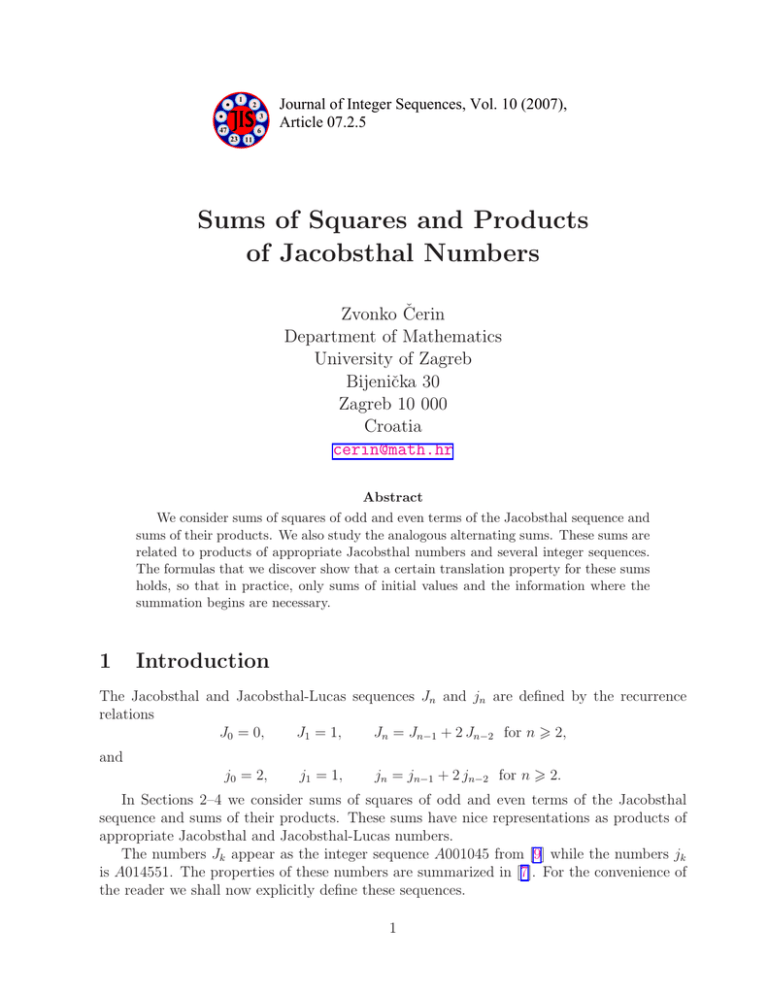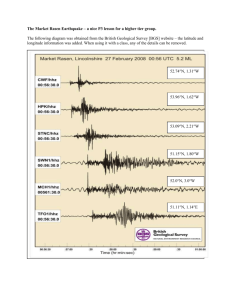Sums of Squares and Products of Jacobsthal Numbers Zvonko ˇ Cerin
advertisement

1 2 3 47 6 Journal of Integer Sequences, Vol. 10 (2007), Article 07.2.5 23 11 Sums of Squares and Products of Jacobsthal Numbers Zvonko Čerin Department of Mathematics University of Zagreb Bijenička 30 Zagreb 10 000 Croatia cerin@math.hr Abstract We consider sums of squares of odd and even terms of the Jacobsthal sequence and sums of their products. We also study the analogous alternating sums. These sums are related to products of appropriate Jacobsthal numbers and several integer sequences. The formulas that we discover show that a certain translation property for these sums holds, so that in practice, only sums of initial values and the information where the summation begins are necessary. 1 Introduction The Jacobsthal and Jacobsthal-Lucas sequences Jn and jn are defined by the recurrence relations J0 = 0, J1 = 1, Jn = Jn−1 + 2 Jn−2 for n > 2, and j0 = 2, j1 = 1, jn = jn−1 + 2 jn−2 for n > 2. In Sections 2–4 we consider sums of squares of odd and even terms of the Jacobsthal sequence and sums of their products. These sums have nice representations as products of appropriate Jacobsthal and Jacobsthal-Lucas numbers. The numbers Jk appear as the integer sequence A001045 from [9] while the numbers jk is A014551. The properties of these numbers are summarized in [7]. For the convenience of the reader we shall now explicitly define these sequences. 1 The first eleven terms of the sequence Jk are 0, 1, 1, 3, 5, 11, 21, 43, 85, 171 and 341. It n n . is given by the formula Jn = 2 −(−1) 3 The first eleven terms of the sequence jk are 2, 1, 5, 7, 17, 31, 65, 127, 257, 511 and 1025. It is given by the formula jn = 2n + (−1)n . In the last three sections we look into the alternating sums of squares of odd and even terms of the Jacobsthal sequence and the alternating sums of products of two consecutive Jacobsthal numbers. These sums also have nice representations as products of appropriate Jacobsthal and Jacobsthal-Lucas numbers. These formulas for ordinary sums and for alternating sums have been discovered with the help of a PC computer and all algebraic identities needed for the verification of our theorems can be easily checked in either Derive, Mathematica or Maple V. Running times of all these calculations are in the range of a few seconds. Similar results for Fibonacci, Lucas, Pell, and Pell-Lucas numbers have recently been discovered by G. M. Gianella and the author in papers [1, 2, 3, 4, 5, 6]. They improved some results in [8]. 2 Jacobsthal even squares The following lemma is needed to accomplish the inductive step in the proof of the first part of our first theorem. 4n+2 4n+2 4n For any n = 0, 1, 2, . . . let βn = 2 3 −1 = J4n+2 , γn = 2 5 +1 = j4n+2 and τn = 2 15−1 = J54n . 5 Lemma 1. For every m > 0 and k > 0 the following equality holds 2 (βn+1 γn+1 − βn γn ) J2k + 8 (βn+1 τn+1 − βn τn ) J2k 2 2 2 2 = J2k+4n+4 + J2k+4n+2 − J4n+4 − J4n+2 . (2.1) Proof. (P1). Let A = 22k , B = 28n and C = 24n . The difference of the left hand side and the right hand side of the relation (2.1) is equal to ´ ´ 40 ³ 544 ³ 1+2 k 4 n+2 k 1+4 n (A + 1)C (−1) + 1 AB + (−1) + (−1) 9 9 ´ ³ ´ 272 2 ³ 4k 1+2 k 8n 1+8 n+4 k + . (−1) + 2 (−1) +1 B+ (−1) + (−1) 9 9 It is obvious that all coefficients in the above expression are zero and the proof is complete. There are essentially three types of proofs in this paper that we indicate as P1, P2 and P3. In P1 and P2 we use the substitutions A = 22k , B = 28n , C = 24n and M = 2k , P = (−1)k , respectively. We prove that the difference of the left hand side and the right hand side of the relation from the statement is equal to zero with algebraic simplification to an expression that is obviously vanishing. This part is easily done with the help of a computer (for example in Maple V) so that we shall only indicate the final expression. 2 In P3 we argue by induction on n taking care first of the initial value n = 0 and then showing that it holds for n = r + 1 under the assumption that it is true for n = r. The following lemma is needed to accomplish the inductive step in the proof of the second part of our first theorem. For any n = 0, 1, 2, . . . let ηn = 24n+4 + 1 = j4n+4 . Lemma 2. For every m > 0 and k > 0 the following equality holds 2 (τn+2 ηn+1 − τn+1 ηn ) J2k + 8 (βn+1 τn+2 − βn τn+1 ) J2k 2 2 2 2 = J2k+4n+6 + J2k+4n+4 − J4n+6 − J4n+4 . (2.2) Proof. (P1). ´ ´ 160 ³ 8704 ³ (−1)1+2 k + 1 AB + (−1)4 n+2 k + (−1)1+4 n (A + 1)C 9 9 ´ ´ 4352 ³ 2 ³ + (−1)4 k + 2 (−1)1+2 k + 1 B + (−1)8 n + (−1)1+8 n+4 k . 9 9 Theorem 1. For every m > 0 and k > 0 the following equalities hold m X 2 J2k+2i = i=0 m X 2 J2i + βn J2 k [γn J2k + 8 τn ] , (2.3) 2 J2i + τn+1 J2 k [ηn J2k + 8 βn ] , (2.4) i=0 if m = 2n and n = 0, 1, 2, . . . and m X 2 J2k+2i = i=0 m X i=0 if m = 2n + 1 and n = 0, 1, 2, . . .. Proof of (2.3). (P3). The proof is by induction on n. When n = 0 we obtain 2 2 J2k = J02 + β0 J2k [γ0 J2k + 8 τ0 ] = J2k J2k = J2k , because J0 = 0, β0 = 1, γ0 = 1 and τ0 = 0. Assume that the relation (2.3) is true for n = r. Then 2(r+1) X 2 J2k+2i = 2 J2k+4r+2 + i=0 2 J2k+4r+4 + 2r X 2 2 2 J2k+2i = J2k+4r+2 + J2k+4r+4 + i=0 2r X 2(r+1) 2 J2i + βr J2 k [γr J2k + 8 τr ] = X 2 J2i + βr+1 J2 k [γr+1 J2k + 8 τr+1 ] , i=0 i=0 where the last step uses Lemma 1 for n = r + 1. Hence, (2.3) is true for n = r + 1 and the proof is completed. 3 Proof of (2.4). (P3). When n = 0 we obtain 2 2 2 J2k + J2k+2 = J02 + J22 + τ1 J2k [η0 J2k + 8 β0 ] = 17 J2k + 8 J2k + 1, since J0 = 0, J1 = 1, β0 = 1, η0 = 17 and τ1 = 1. The above equality is equivalent to 2 2 J2k+2 = 16 J2k + 8 J2k + 1 = (4 J2k + 1)2 which is true because it follows from the relation Jn+2 = 4 Jn + 1. Assume that the relation (2.4) is true for n = r. Then 2(r+1)+1 X 2 J2k+2i = i=0 2 J2k+4r+4 + 2 J2k+4r+6 + 2r+1 X 2 2 2 J2k+2i = J2k+4r+4 + J2k+4r+6 + i=0 2r+1 X 2(r+1)+1 2 J2i + τr+1 J2 k [ηr J2k + 8 βr ] = X 2 J2i + τr+2 J2 k [ηr+1 J2k + 8 βr+1 ] , i=0 i=0 where the last step uses Lemma 2 for n = r + 1. 3 Jacobsthal odd squares The initial step in an inductive proof of the first part of our second theorem uses the following lemma. Lemma 3. For every k > 0 the following identity holds 2 J2k+1 = 16 J2k J2k−2 + 8 J2k + 1. Proof. (P2). Let M = 2k and P = (−1)k . The difference of the left and the right hand side +1) (8 M 2 − 5 P 2 + 3) = 0. is equal to (P −1)(P 3 The initial step in an inductive proof of the second part of our second theorem uses the following lemma. Lemma 4. For every k > 0 the following identity holds 2 2 J2k+1 + J2k+3 = 10 + 8 J2k (34 J2k−2 + 15). Proof. (P2). 10 (P − 1) (P + 1) (4 M 2 − 3 P 2 + 1). The following lemma is needed to accomplish the inductive step in the proof of the first part of our second theorem. 4n+1 For any n = 0, 1, 2, . . . let πn = 2 3 −1 = J4n+1 . Lemma 5. For every m > 0 and k > 0 the following equality holds 8 J2k [2 (βn+1 γn+1 − βn γn ) J2k−2 + βn+1 πn+1 − βn πn ] 2 2 2 2 = J2k+4n+5 + J2k+4n+3 − J4n+5 − J4n+3 . 4 (3.1) Proof. (P1). ´ ´ 80 ³ 5440 ³ (−1)1+2 k + 1 AB + (−1)4 n+2 k+1 + (−1)4 n (A + 1)C 9 9 ´ ´ 2 ³ 1088 ³ 4 (−1)4 k + 5 (−1)1+2 k + 1 B + (−1)8 n + (−1)8 n+4 k+1 . + 9 9 The following lemma is needed to accomplish the inductive step in the proof of the second part of our second theorem. For any n = 0, 1, 2, . . . let σn = 5 J4n+3 . Lemma 6. For every m > 0 and k > 0 the following equality holds 8 J2k [2 (τn+2 ηn+1 − τn ηn ) J2k−2 + τn+2 σn+1 − τn+1 σn ] 2 2 2 2 = J2k+4n+7 + J2k+4n+5 − J4n+7 − J4n+5 . (3.2) Proof. (P1). ´ ´ 320 ³ 87040 ³ (−1)1+2 k + 1 AB + (−1)4 n+2 k+1 + (−1)4 n (A + 1)C 9 9 ´ ´ 17408 ³ 2 ³ + 4 (−1)4 k + 5 (−1)1+2 k + 1 B + (−1)8 n + (−1)8 n+4 k+1 . 9 9 Theorem 2. For every m > 0 and k > 0 the following equalities hold m X 2 J2k+2i+1 = i=0 m X 2 J2i+1 + 8 βn J2 k [2 γn J2k−2 + πn ] , (3.3) 2 J2i+1 + 8 τn+1 J2 k [2 ηn J2k−2 + σn ] , (3.4) i=0 if m = 2n and n = 0, 1, 2, . . . and m X 2 J2k+2i+1 i=0 = m X i=0 if m = 2n + 1 and n = 0, 1, 2, . . .. Proof of (3.3). (P3). When n = 0 we obtain 2 J2k+1 = J12 + 8 β0 J2k [2 γ0 J2k−2 + π0 ] = 1 + 8 J2k [2 J2k−2 + 1], because J1 = 1, β0 = 1, γ0 = 1 and π0 = 1. But, this equality is true by Lemma 3. Assume that the relation (3.3) is true for n = r. Then 2(r+1) X i=0 2 J2k+2i+1 = 2 J2k+4r+5 + 2 J2k+4r+3 + 2r X 2 J2k+2i+1 i=0 = 2 J2k+4r+5 + 2 J2k+4r+3 + 2r X 2 J2i+1 i=0 2(r+1) + 8 βn J2 k [2 γn J2k−2 + πn ] = X i=0 where the last step uses Lemma 5 for n = r + 1. 5 2 J2i+1 + 8 βn+1 J2 k [2 γn+1 J2k−2 + πn+1 ] , Proof of (3.4). (P3). The proof is by induction on n. When n = 0 we obtain 2 2 J2k+1 + J2k+3 = J12 + J32 + 8 τ1 J2 k [2 η0 J2k−2 + σ0 ] = 10 + 8 J2 k [34 J2k−2 + 15] , since J1 = 1, J3 = 3, τ1 = 1, η0 = 17 and σ0 = 15. The above equality is true by Lemma 4. Assume that the relation (3.4) is true for n = r. Then 2(r+1)+1 X 2 J2k+2i+1 2 J2k+4r+7 = + 2 J2k+4r+5 + i=0 2r+1 X 2 J2k+2i+1 = i=0 2 2 J2k+4r+7 + J2k+4r+5 + 2r+1 X 2 J2i+1 + 8 τr+1 J2 k [2 ηr J2k−2 + σr ] i=0 2(r+1)+1 = X 2 J2i+1 + 8 τr+2 J2 k [2 ηr+1 J2k−2 + σr+1 ] , i=0 where the last step uses Lemma 6 for n = r + 1. 4 Jacobsthal products For the first two steps in a proof by induction of our next theorem we require the following lemma. Lemma 7. For every k > 0 the following equalities hold J2k+1 = 8 J2k−2 + 3. (4.1) J2k J2k+1 + J2k+2 J2k+3 = 3 + J2k (136 J2k−2 + 55). (4.2) Proof of (4.1). By the formula Jk = J2k+1 2k −(−1)k 3 we have 22k+1 + 1 22k−2 − (−1)2k−2 22k+1 − (−1)2k+1 = = 8· + 3 = 8 J2k−2 + 3. = 3 3 3 Proof of (4.2). (P2). (P −1)(P +1) 3 (55 M 2 − 46 P 2 + 9) . With the following lemma we shall make the inductive step in the proof of the first part of our third theorem. Lemma 8. For every m > 0 and k > 0 the following equality holds J2k [8 (βn+1 γn+1 − βn γn ) J2k−2 + βn+1 µn+1 − βn µn ] = J2k+4n+5 J2k+4n+4 + J2k+4n+3 J2k+4n+2 − J4n+5 J4n+4 − J4n+3 J4n+2 . 6 (4.3) Proof. (P1). ´ ´ 20 ³ 2720 ³ (−1)1+2 k + 1 AB + (−1)4 n+2 k + (−1)4 n+1 (A + 1)C+ 9 9 ´ ´ 2 ³ 544 ³ 4 (−1)4 k + 5 (−1)1+2 k + 1 B + (−1)8 n+1 + (−1)8 n+4 k . 9 9 With the following lemma we shall make the inductive step in the proof of the second part of our third theorem. Lemma 9. For every m > 0 and k > 0 the following equality holds J2k [8 (τn+2 ηn+1 − τn+1 ηn ) J2k−2 + τn+2 νn+1 − τn+1 νn ] = J2k+4n+5 J2k+4n+4 + J2k+4n+7 J2k+4n+6 − J4n+5 J4n+4 − J4n+7 J4n+6 . (4.4) Proof. (P1). ´ ´ 80 ³ 43520 ³ (−1)1+2 k + 1 AB + (−1)4 n+2 k + (−1)4 n+1 (A + 1) C 9 9 ´ ´ 2 ³ 8704 ³ 4 (−1)4 k + 5 (−1)1+2 k + 1 B + (−1)8 n+1 + (−1)8 n+4 k . + 9 9 For any n = 0, 1, 2, . . . let µn = 24n+3 +1 3 = J4n+3 and νn = 5 (24n+5 +1) 3 = 5 J4n+5 . Theorem 3. For every m > 0 and k > 0 the following equalities hold m X J2k+2i J2k+2i+1 = i=0 m X J2i J2i+1 + βn J2 k [8 γn J2k−2 + µn ] , (4.5) J2i J2i+1 + τn+1 J2 k [8 ηn J2k−2 + νn ] , (4.6) i=0 if m = 2n and n = 0, 1, 2, . . . and m X J2k+2i J2k+2i+1 = i=0 m X i=0 if m = 2n + 1 and n = 0, 1, 2, . . .. Proof of (4.5). (P3). For n = 0 the relation (4.5) is J2k J2k+1 = J0 J1 + β0 J2k (8 γ0 J2k−2 + µ0 ) = J2k (8 J2k−2 + 3) which is true since J2k+1 = 8 J2k−2 + 3 by the relation (4.1) in Lemma 7. 7 Assume that the relation (4.5) is true for n = r. Then 2(r+1) X J2k+2i J2k+2i+1 = J2k+4r+4 J2k+4r+5 + J2k+4r+2 J2k+4r+3 + i=0 2r X J2k+2i J2k+2i+1 = i=0 2r X J2k+4r+4 J2k+4r+5 + J2k+4r+2 J2k+4r+3 + J2i J2i+1 + βn J2 k [8 γn J2k−2 + µn ] i=0 2(r+1) X = J2i J2i+1 + βn+1 J2 k [8 γn+1 J2k−2 + µn+1 ] , i=0 where the last step uses Lemma 8 for n = r + 1. Proof of (4.6). (P3). For n = 0 the relation (4.6) is J2k J2k+1 + J2k+2 J2k+3 = J0 J1 + J2 J3 + τ1 J2k (8 η0 J2k−2 + ν0 ) = 3 + J2k (136 J2k−2 + 55) which is true by (4.2) in Lemma 7. Assume that the relation (4.6) is true for n = r. Then 2(r+1)+1 X J2k+2i J2k+2i+1 = J2k+4r+4 J2k+4r+5 + J2k+4r+6 J2k+4r+7 + i=0 2r+1 X J2k+2i J2k+2i+1 = i=0 J2k+4r+4 J2k+4r+5 + J2k+4r+6 J2k+4r+7 + 2r+1 X J2i J2i+1 + τn+1 J2 k [8 ηn J2k−2 + νn ] i=0 2(r+1)+1 = X J2i J2i+1 + τn+2 J2 k [8 ηn+1 J2k−2 + νn+1 ] , i=0 where the last step uses Lemma 9 for n = r + 1. 5 Alternating Jacobsthal even squares In this section we look for formulas that give closed forms for alternating sums of squares of Jacobsthal numbers with even indices. Lemma 10. For every k > 0 we have J2k = 4 J2k−2 + 1. Proof. By the formula Jk = 2k −(−1)k 3 4 J2k−2 + 1 = 4 · we get 22k − (−1)2k 22k−2 − (−1)2k−2 +1= = J2k . 3 3 8 (5.1) Lemma 11. For every k > 0 we have 2 2 J2k+2 − J2k = 1 + J2k (60 J2k−2 + 23). Proof. (P2). (P −1)(P +1) 3 (5.2) (23 M 2 − 20 P 2 + 3) . ∗ Let τ0∗ = 1 and τn+1 − τn∗ = 24n+3 (50 · 24n − 1), for n = 0, 1, 2, . . .. For any n = 0, 1, 2, . . . 8n+4 j . let γn∗ = 2 17 +1 = 8n+4 17 Lemma 12. For every k > 0 and every n > 0 we have ∗ ∗ 2 2 2 2 J2k (4 (γn+1 − γn∗ ) J2k−2 + τn+1 − τn∗ ) = J2k+4n+4 − J2k+4n+2 − J4n+4 + J4n+2 . (5.3) Proof. (P1). ´ ´ 400 ³ 8 ³ (−1)1+2 k + 1 AB + (−1)4 n+2 k − 1 AC+ 3 3 ´ ´ 8 ³ 80 ³ 4 (−1)4 k + 5 (−1)1+2 k + 1 B + (−1)2 k + (−1)4 n+1 C. 3 3 ∗ Let β0∗ = 23 and βn+1 − βn∗ = 24n+5 (200 · 24n − 1) for any n = 0, 1, 2, . . .. For the same 8n+8 3 values of n, let ηn∗ = 2 17 −1 = 17 J8n+8 . Lemma 13. For every k > 0 and every n > 0 we have ∗ ∗ 2 2 2 2 J2k (4 (ηn+1 − ηn∗ ) J2k−2 + βn+1 − βn∗ ) = J2k+4n+6 − J2k+4n+4 + J4n+4 − J4n+6 . (5.4) Proof. (P1). ´ ´ 6400 ³ 32 ³ (−1)1+2 k + 1 AB + (−1)4 n+2 k − 1 AC+ 3 3 ´ ´ 32 ³ 1280 ³ 4 (−1)4 k + 5 (−1)1+2 k + 1 B + (−1)2 k + (−1)4 n+1 C. 3 3 Theorem 4. For every m > 0 and k > 0 the following equalities hold m X 2 (−1)i J2k+2i = i=0 m X 2 (−1)i J2i + J2 k [4 γn∗ J2k−2 + τn∗ ] , (5.5) m X 2 (−1)i J2i − J2 k [4 ηn∗ J2k−2 + βn∗ ] , (5.6) i=0 if m = 2n and n = 0, 1, 2, . . . and m X i (−1) 2 J2k+2i i=0 = i=0 if m = 2n + 1 and n = 0, 1, 2, . . .. 9 Proof of (5.5). (P3). For n = 0 the relation (5.5) is 2 J2k = J02 + J2k (4 γ0∗ J2k−2 + τ0∗ ) = J2k (4 J2k−2 + 1) (i. e., the relation (5.1) multiplied by J2k ) which is true by Lemma 10. Assume that the relation (5.5) is true for n = r. Then 2(r+1) X 2 (−1)i · J2k+2i = Q22k+4r+4 − Q22k+4r+2 + i=0 2r X 2 (−1)i · J2k+2i i=0 = Q22k+4r+4 − Q22k+4r+2 + 2r X 2 (−1)i · J2i + J2 k [4 γn∗ J2k−2 + τn∗ ] = i=0 2(r+1) X £ ∗ ¤ 2 ∗ (−1)i · J2i + J2 k 4 γn+1 J2k−2 + τn+1 , i=0 where the last step uses Lemma 12. Proof of (5.6). (P3). For n = 0 the relation (5.6) is 2 2 J2k − J2k+2 = (J02 − J22 ) − J2 k [4 η0∗ J2k−2 + β0∗ ] = −1 − J2 k [60 J2k−2 + 23] , which is true by Lemma 11. Assume that the relation (5.6) is true for n = r. Then 2(r+1)+1 X i (−1) · 2 J2k+2i = 2 J2k+4r+4 − 2 J2k+4r+6 + i=0 2r+1 X 2 (−1)i · J2k+2i i=0 2 2 − J2k+4r+6 + = J2k+4r+4 2r+1 X 2 (−1)i · J2i − J2 k [4 ηn∗ J2k−2 + βn∗ ] i=0 2(r+1)+1 = X i=0 £ ∗ ¤ 2 ∗ (−1)i · J2i − J2 k 4 ηn+1 J2k−2 + βn+1 , where the last step uses Lemma 13. 6 Alternating Jacobsthal odd squares In this section we look for formulas that give closed forms for alternating sums of squares of Jacobsthal numbers with odd indices. Lemma 14. For every k > 0 we have 2 J2k+1 = 1 + 8 J2k [2 J2k−2 + 1] . Proof. (P2). (P −1)(P +1) 3 (8 M 2 − 5 P 2 + 3) . 10 (6.1) Lemma 15. For every k > 0 we have 2 2 J2k+3 − J2k+1 = 8 + 8 J2k (30 J2k−2 + 13). Proof. (P2). (P −1)(P +1) 3 (6.2) (13 M 2 − 10 P 2 + 3) . ∗∗ Let τ0∗∗ = 1 and τn+1 − τn∗∗ = 101 · 24n+1 + 25 · 24n+3 (24n − 1) for n = 0, 1, 2, . . .. Lemma 16. For every k > 0 and every n > 0 we have ∗ ∗∗ 2 2 2 2 8 J2k (2 (γn+1 − γn∗ ) J2k−2 + τn+1 − τn∗∗ ) = J2k+4n+5 − J2k+4n+3 − J4n+5 + J4n+3 . (6.3) Proof. (P1). ´ ´ 16 ³ 1600 ³ (−1)1+2 k + 1 AB + (−1)4 n+2 k+1 + 1 AC+ 3 3 ´ ´ 16 ³ 320 ³ 4 (−1)4 k + 5 (−1)1+2 k + 1 B + (−1)2 k+1 + (−1)4 n C. 3 3 ∗∗ Let β0∗∗ = 13 and βn+1 − βn∗∗ = 401 · 24n+3 + 100 · 24n+5 (24n − 1) for any n = 0, 1, 2, . . .. Lemma 17. For every k > 0 and every n > 0 we have ∗ ∗∗ 2 2 2 2 8 J2k (2 (ηn+1 − ηn∗ ) J2k−2 + βn+1 − βn∗∗ ) = J2k+4n+7 − J2k+4r+5 + J4n+5 − J4r+7 . (6.4) Proof. (P1). ´ ´ 64 ³ 25600 ³ (−1)1+2 k + 1 AB + (−1)4 n+2 k+1 + 1 AC+ 3 3 ´ ´ 5120 ³ 64 ³ 4 (−1)4 k + 5 (−1)1+2 k + 1 B + (−1)2 k+1 + (−1)4 n C. 3 3 Theorem 5. For every m > 0 and k > 0 the following equalities hold m X i (−1) 2 J2k+2i+1 = i=0 m X 2 (−1)i J2i+1 + 8 J2 k [2 γn∗ J2k−2 + τn∗∗ ] , (6.5) m X 2 (−1)i J2i+1 − 8 J2 k [2 ηn∗ J2k−2 + βn∗∗ ] , (6.6) i=0 if m = 2n and n = 0, 1, 2, . . . and m X i (−1) 2 J2k+2i+1 = i=0 i=0 if m = 2n + 1 and n = 0, 1, 2, . . .. 11 Proof of (6.5). (P3). For n = 0 the relation (6.5) is 2 J2k+1 = J12 + 8 J2k (2 γ0∗ J2k−2 + τ0∗∗ ) (i. e., the relation (6.1)) which is true by Lemma 14. Assume that the relation (6.5) is true for n = r. Then 2(r+1) X 2r X 2 2 2 (−1)i J2k+2i+1 = J2k+4r+5 − J2k+4r+3 + i=0 2 (−1)i J2k+2i+1 i=0 2 2 = J2k+4r+5 − J2k+4r+3 + 2r X 2 (−1)i J2i+1 + 8 J2 k [2 γn∗ J2k−2 + τn∗∗ ] i=0 2(r+1) = X £ ∗ ¤ 2 ∗∗ (−1)i J2i+1 + 8 J2 k 2 γn+1 J2k−2 + τn+1 , i=0 where the last step uses Lemma 16. Proof of (6.6). (P3). The proof is again by induction on n. For n = 0 the relation (6.6) is 2 2 J2k+1 − J2k+3 = J12 − J32 − 8 J2 k [2 η0∗ J2k−2 + β0∗∗ ] which is true by Lemma 15 since η0∗ = 15 ∗∗ and β0 = 13. Assume that the relation (6.6) is true for n = r. Then 2(r+1)+1 X i (−1) 2 J2k+2i+1 = 2 J2k+4r+5 − 2 J2k+4r+7 + i=0 2r+1 X 2 (−1)i J2k+2i+1 i=0 2 2 = J2k+4r+5 − J2k+4r+7 + 2r+1 X 2 (−1)i J2i+1 − 8 J2 k [2 ηn∗ J2k−2 + βn∗∗ ] i=0 2(r+1)+1 = X i=0 £ ∗ ¤ 2 ∗∗ (−1)i J2i+1 − 8 J2 k 2 ηn+1 J2k−2 + βn+1 , where the last step uses Lemma 17. 7 Alternating Jacobsthal products Lemma 18. For every k > 0 we have J2k+3 J2k+2 − J2k+1 J2k = 3 + J2k [120 J2k−2 + 49] . Proof. (P2). (P −1)(P +1) 3 (7.1) (49 M 2 − 40 P 2 + 9) . Lemma 19. For every k > 0 and every n > 0 we have ¡ ¢ ∗ ∗∗∗ − γn∗ ) J2k−2 + τn+1 − τn∗∗∗ = J2k 8 (γn+1 J2k+4n+5 J2k+4n+4 − J2k+4n+3 J2k+4n+2 − J4n+5 J4n+4 + J4n+3 J4n+2 . 12 (7.2) Proof. (P1). ´ ´ 4 ³ 800 ³ (−1)1+2 k + 1 AB + (−1)4 n+2 k − 1 AC+ 3 3 ´ ´ 4 ³ 160 ³ 4 (−1)4 k + 5 (−1)1+2 k + 1 B + (−1)2 k + (−1)4 n+1 C. 3 3 ∗∗∗ Let β0∗∗∗ = 49 and βn+1 − βn∗∗∗ = 799 · 24n+4 + 25 · 24n+9 (24n − 1) for any n = 0, 1, 2, . . .. Lemma 20. For every k > 0 and every n > 0 we have ∗ ∗∗∗ J2k (8 (ηn+1 − ηn∗ ) J2k−2 + βn+1 − βn∗∗∗ ) = J2k+4n+6 J2k+4n+7 − J2k+4n+4 J2k+4n+5 + J4n+5 J4n+4 − J4n+6 J4n+7 . (7.3) Proof. (P1). ´ ´ 16 ³ 12800 ³ (−1)1+2 k + 1 AB + (−1)4 n+2 k − 1 AC+ 3 3 ´ ´ 2560 ³ 16 ³ 4 (−1)4 k + 5 (−1)1+2 k + 1 B + (−1)2 k + (−1)4 n+1 C. 3 3 Theorem 6. For every m > 0 and k > 0 the following equalities hold m m X X i (−1) J2k+2i J2k+2i+1 = (−1)i J2i J2i+1 + J2 k [8 γn∗ J2k−2 + τn∗∗∗ ] , i=0 (7.4) i=0 if m = 2n and n = 0, 1, 2, . . . and m m X X i (−1) J2k+2i J2k+2i+1 = (−1)i J2i J2i+1 − J2 k [8 ηn∗ J2k−2 + βn∗∗∗ ] , i=0 (7.5) i=0 if m = 2n + 1 and n = 0, 1, 2, . . .. Proof of (7.4). (P3). For n = 0 the relation (7.4) is J2k J2k+1 = J0 J1 + J2 k [8 γ0∗ J2k−2 + τ0∗∗∗ ] = J2 k [8 J2k−2 + 3] which is true by the relation (4.1) in Lemma 7 since J0 = 0, J1 = 1, γ0∗ = 1 and τ0∗∗∗ = 3. Assume that the relation (7.4) is true for n = r. Then 2(r+1) X i=0 i (−1) J2k+2i J2k+2i+1 = 2r X (−1)i J2k+2i J2k+2i+1 + J2k+4r+4 J2k+4r+5 − J2k+4r+2 J2k+4r+3 i=0 = J2k+4r+4 J2k+4r+5 − J2k+4r+2 J2k+4r+3 + 2r X (−1)i J2i J2i+1 + J2 k [8 γn∗ J2k−2 + τn∗∗∗ ] i=0 2(r+1) = X i=0 where the last step uses Lemma 19. 13 £ ∗ ¤ ∗∗∗ (−1)i J2i J2i+1 + J2 k 8 γn+1 J2k−2 + τn+1 , Proof of (7.5). (P3). For n = 0 the relation (7.5) is J2k J2k+1 − J2k+2 J2k+3 = J0 J1 − J2 J3 − J2k [8 η0∗ J2k−2 + β0∗∗∗ ] = −3 − J2k [120 J2k−2 + 49] , (i. e., the relation (7.1)) which is true by Lemma 18. Assume that the relation (7.5) is true for n = r. Then 2(r+1)+1 X i (−1) J2k+2i J2k+2i+1 = i=0 2r+1 X (−1)i J2k+2i J2k+2i+1 + J2k+4r+4 J2k+4r+5 − i=0 J2k+4r+6 J2k+4r+7 = J2k+4r+4 J2k+4r+5 − J2k+4r+6 J2k+4r+7 + 2r+1 X (−1)i J2i J2i+1 − i=0 2(r+1)+1 J2 k [8 ηn∗ J2k−2 + βn∗∗∗ ] = X i=0 £ ∗ ¤ ∗∗∗ (−1)i J2i J2i+1 − J2 k 8 ηn+1 J2k−2 + βn+1 , where the last step uses Lemma 20. References [1] Z. Čerin, Properties of odd and even terms of the Fibonacci sequence, Demonstratio Math., 39 (2006), 55–60. [2] Z. Čerin, On sums of squares of odd and even terms of the Lucas sequence, Proccedings of the 11th Fibonacci Conference, to appear. [3] Z. Čerin, Some alternating sums of Lucas numbers, Central European J. Math. 3 (2005), 1–13. [4] Z. Čerin, Alternating sums of Fibonacci products, Atti del Seminario Matematico e Fisico dell’Università di Modena e Reggio Emilia, (to appear). [5] Z. Čerin and G. M. Gianella, On sums of squares of Pell-Lucas numbers, INTEGERS: Electronic Journal of Combinatorial Number Theory, 6 (2006), # A15. Available at http://www.integers-ejcnt.org/vol6.html. [6] Z. Čerin and G. M. Gianella, Formulas for sums of squares and products of Pell numbers, Acc. Sc. Torino - Atti Sci. Fis. 140 (2006), to appear. [7] A. F. Horadam, Jacobsthal representation numbers, Fib. Quart. 34 (1996), 40–54. [8] V. Rajesh and G. Leversha, Some properties of odd terms of the Fibonacci sequence, Math. Gazette, 88 (2004), 85–86. [9] N. J. A. Sloane, The On-Line Encyclopedia of Integer Sequences, 2006. 14 2000 Mathematics Subject Classification: Primary 11B39; Secondary 11Y55, 05A19. Keywords: Jacobsthal numbers, Jacobsthal-Lucas numbers, integer sequences, sum of squares, combinatorial identity, Maple. (Concerned with sequences A001045 and A014551.) Received May 17 2006; revised version received January 19 2007. Published in Journal of Integer Sequences, January 19 2007. Return to Journal of Integer Sequences home page. 15









